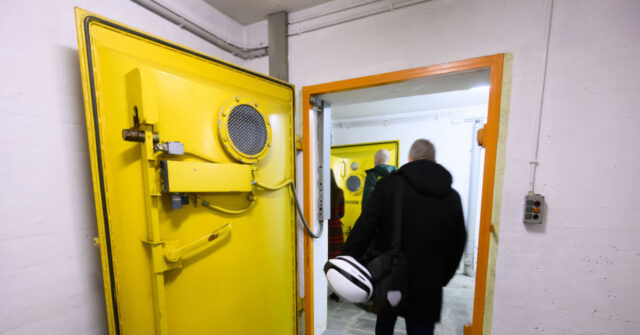We support our Publishers and Content Creators. You can view this story on their website by CLICKING HERE.

Germany is working on a ‘bunker plan’ including a smartphone app to direct citizens to the nearest shelter in case of an emergency, a report claims, after Russian President Putin said he reserved the right to bomb the allies of Ukraine.
The Bundesamt für Bevölkerungsschutz und Katastrophenhilfe — it really rolls off the tongue — better known as the BKK or the Federal Office for Civil Protection and Disaster Assistance has embarked on a project to figure out where the country’s remaining bomb shelters are and how many are still fit for use. As well as now long-neglected facilities designed for the purpose officials will also be looking at the potential to convert subway stations, government buildings, and even private basements, a report in newspaper Bild asserts.
German broadcaster ZDF interprets the revelation of what is called the “bunker plan” as being part of the nation’s response to Russia bombing Ukrainian city Dnipro with an unarmed nuclear-capable ballistic missile last week. The weapon was a new design, Russian President Vladimir Putin claimed, asserting it is both ‘hypersonic’ and impervious to countermeasures, its launch seen as a clear message to Ukraine’s backers.
President Putin spoke shortly after the launch, where he said the launch had been “in response to the use of American and British long-range weapons”. Chillingly, in a message to NATO states which have supplied Ukraine with long range precision strike weapons being used to hit military targets inside Russia itself, Putin said: “We consider ourselves entitled to use our weapons against the military facilities of those countries that allow their weapons to be used against our facilities.”
At the end of the Cold War Germany has 2,000 public shelters, it is reported, but with the fall of the Soviet Union the need for such facilities was seen to have passed and the funding stopped. Years later many had fallen into disrepair and a sell-off began in the early 2000s, with many becoming private residences, places of business, art galleries, tourist attractions, even hotels and musroom farms.
The sell-off continued until 2022, when Russia’s invasion of Ukraine began again and disposals were suspended. Today the Federal government owns just 579 shelters with spaces for 480,000, the Federal Interior Ministry says.
The BKK is now, it is reported, discovering how many of the old shelters still exist in serviceable condition and which could be pressed back into service in a crisis, and how many other new spaces could be converted if need be. The work will doubtless have learnt much from the Ukrainian experience, where many shelters from the relentless Russian air raids that exist now have been established in converted spaces meant for other purposes.
The national survey will assess the structural condition of locations including their doors and ventilation systems. Private and public property including underground garages, subway stations, government buildings, and basements are to be surveyed in what has been called a “major project” that is expected to take a considerable period of time to complete.
As for the public, there is apparently an expectation in the yet to be officially announced initiative on them to make preparations, too. As stated in the Bild report, the public are expected to do something with their own basement spaces and not necessarily wait for the government to act. As part of the project, there is to be a mobile phone app that directs users to their nearest bomb shelter in a crisis: this too is Ukraine-inspired, where such an app is already in daily use.
While the nationwide survey is apparently to assess what is available and what is possible for the future, there is reportedly no plans by the German government to actually supply any new shelter spaces or bunkers. ZDF cites Berlin’s position from this summer that “Centrally located public shelters for several hundred or thousand people are not an appropriate protective measure against modern precision weapons that specifically destroy individual war-relevant objects and for which there is only a few minutes’ warning time before an attack.”
It is not clear to what degree this decades-old conventional view on the future of warfare has actually been vindicated by the real experience of the Ukraine war, however, where relatively unsophisticated mass strikes by artillery and bomb drones have struck pretty indiscriminately at Ukrainian cities. In many areas, nearly as much damage has been caused by falling wreckage from downed weapons as by the strikes themselves, again counting against the precision warfare concept.
Indeed, the lack of provision of bomb shelter places across Ukraine in the early months of the invasion became a major scandal in Ukraine as people were killed after being unable to reach a bunker in time, or because what was available locally when the war broke out wasn’t actually bomb-proof at all.
In Germany, some bunkers are already well known. Beyond the colossal remnants of Nazi Germany’s defensive structures built in the Second World War, some of which were simply too large to demolish, the country also has many Cold War era bunkers. One is at Pankstrasse U-Bahn station on Berlin’s underground train network, which when built new in 1977 also incorporated a bunker by a design to one of the BBK’s predecessor agencies to shelter over 3,000 people in case of war.
Not all regions have provision, however. Germany’s Welt reports the Federal state of Saxony-Anhalt in eastern Germany — part of the region of the country that would be most at threat should the much-discussed escalation of the Ukraine War reach catastrophic levels — doesn’t have a single public bomb shelter.
Other countries closer to the Ukraine War than even Germany have been somewhat more proactive, and not even necessarily against Russia consciously trying to attack NATO territory but because sometimes missiles over-shoot. Poland has seen several ‘lost’ munitions fired by both Ukraine and Russia end up in their territory, and several villages in Romania on the border with Ukraine have received new bomb shelters to protect them from “falling objects from the surrounding airspace”.

 Conservative
Conservative  Search
Search Trending
Trending Current News
Current News 







